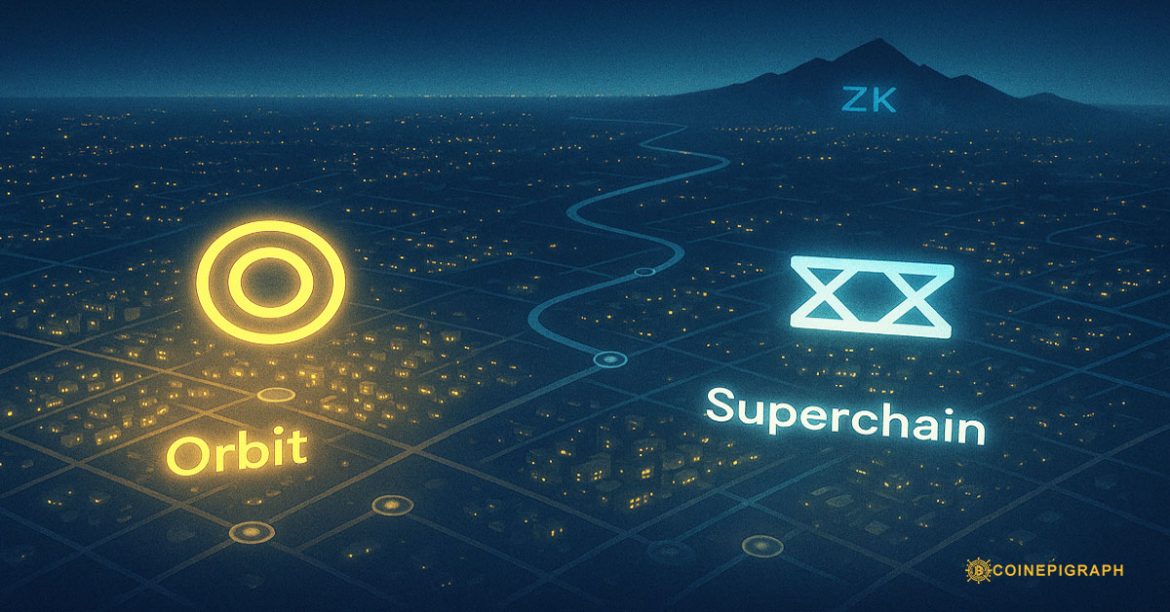CoinEpigraph Editorial Desk | October 12, 2025
TL;DR
The Layer-2 (L2) race has hardened into two power centers—Arbitrum’s Orbit ecosystem and the OP Stack (Base + Optimism “Superchain”)—with ZK stacks accelerating on the flanks. Arbitrum pushed decentralization with BoLD permissionless validation and broadened its franchise via Orbit and Stylus. The OP Stack standardized fault proofs (OP Mainnet live since June 10, 2024) and exported distribution through Base. Meanwhile, EIP-4844 cheapened DA for everyone, and restaked DA (e.g., EigenDA) is reshuffling costs and trust models. The winners will pair credible finality paths with distribution—not just TPS.
The new map in one glance
- Arbitrum: tech breadth + franchise strategy.
• BoLD opens validation and dispute to anyone (bounded liquidity delay), moving Arbitrum chains toward permissionless security.
• Orbit lets teams spin up L2s/L3s under Arbitrum tech with flexible ownership and upgrade control.
• Stylus brings WASM (Rust/C/C++) alongside Solidity—bigger dev surface, lower gas for compute-heavy logic. - OP Stack / Superchain: standardize + distribute.
• Fault proofs shipped June 10, 2024; permissionless challenges on withdrawals are now live on OP Mainnet.
• Base turned Coinbase’s funnel into L2 distribution—users, merchants, and devs—while staying tokenless (to date), compounding network effects for the stack. - ZK flankers (ZKsync et al.).
• ZK stacks promise higher integrity (validity proofs) and are pushing Hyperchains/ZK Stack and ZK Gateway for interop and L3s. Timelines vary, but the toolchains are maturing fast. - Macro tailwind: EIP-4844 (Dencun) put blob space on Ethereum (Mar 13, 2024), slashing DA costs across rollups and changing fee curves.
Arbitrum’s pitch: decentralize the core, franchise the edges
Why builders care:
- Security path: BoLD permissionless validation reduces “multisig trust” on withdrawals across Arbitrum-tech chains.
- Time-to-market: Orbit + ownership controls let teams pick their governance (from DAO-run to corporate), while inheriting a battle-tested stack.
- Developer moat: Stylus lets quant/infra teams write in Rust/C++ with WASM alongside EVM—useful for order books, matching, risk math.
Caveats:
- License/ownership nuance: Business Source-style licensing and chain ownership knobs need reading before you commit; independence is real, but configuration matters.
OP Stack’s pitch: one spec, many chains—plus Base as a distribution engine
Why builders care:
- Security path (today): Fault proofs are live on OP Mainnet, replacing the last major centralized choke in the withdrawal path.
- Distribution: Base gives OP Stack a mass-market onramp—users, merchants, fiat rails—and its growth has been eye-watering through 2025.
- Ecosystem reuse: Tooling, governance patterns, and bridges generalize across OP Stack chains under the “Superchain” banner.
Caveats:
- Tokenless Base? Decentralization roadmap continues without a native token; debates about incentives and governance linger (and rumors surface periodically). Keep plans flexible.
ZK stacks: accelerating, but still uneven
What’s real:
- ZKsync’s ZK Stack / Hyperchains and “ZK Gateway” aim to make L3s and cross-chain messaging verifiable by default, reducing bridge risk and UX friction.
- Trade-offs: Prover throughput, hardware costs, and developer ergonomics vary by stack; many teams still choose optimistic paths for speed/ecosystem even while eyeing ZK for the endgame.
Data availability and the “restaked” option set
- EIP-4844 made Ethereum blob DA cheap(er), shifting many L2s off calldata.
- EigenDA (restaked DA) offers cost/throughput alternatives with Ethereum-aligned security via EigenLayer operators—now commonly considered by rollups optimizing fees and throughput. Design the trust model explicitly if you deviate from L1 DA.
What decides the land grab (a builder’s rubric)
- Finality & exits: Is your chain on a credible path to permissionless fault/validity proofs? What’s the actual withdrawal trust today vs. roadmap?
- Distribution gravity: Can you plug into Base-grade funnels or Orbit-grade app distribution? Users beat TPS on every roadmap.
- Dev surface & tooling: Need Rust/C++ and high-performance math? Stylus is a differentiator. Prefer EVM-pure with shared tooling? OP Stack shines.
- DA costs & guarantees: 4844 blobs vs. EigenDA vs. other DA—price, latency, and failure containment differ. Write it down.
- Governance/ownership: Orbit chains expose clear upgrade/ownership patterns; OP Stack offers well-trodden policies. Pick what your regulator and users can live with.
Risks the market still underprices
- Shared sequencer centralization: Convenience layers (shared/decentralized sequencing) can become single chokepoints if not genuinely heterogeneous.
- Bridge illusions: “Interoperability” without fault/validity guarantees invites correlated failures; ZK messaging helps, but isn’t magic.
- Operator monocultures: The same providers often run RPC, sequencing, and DA—great until an outage cascades. Diversify by default.
- License & IP drift: Business-source or special grants can affect forks/derivatives later—read the footnotes.
👉 “The CoinEpigraph Bottom Line”
“TPS” is yesterday’s scoreboard. The new rollup order is set by credible exits, permissionless verification, and distribution. Arbitrum is selling a franchise + WASM future; the OP Stack is selling standards + Base-scale funnels; ZK stacks are selling integrity at speed. Pick your lane—but write your trust model in ink.
At Coinepigraph, we pride ourselves on delivering cryptocurrency news with the utmost journalistic integrity and professionalism. Our dedicated team is committed to providing accurate, insightful, and unbiased reporting to keep you informed in the ever-evolving crypto landscape. Stay tuned as we expand our coverage to include new sections and thought-provoking op-eds, ensuring Coinepigraph remains your trusted source for all things crypto. -Ian Mayzberg Editor-in-Chief
The team at CoinEpigraph.com is committed to independent analysis and a clear view of the evolving digital asset order.
To help sustain our work and editorial independence, we would appreciate your support of any amount of Bitcoin/Satoshi to this address below: 3NM7AAdxxaJ7jUhZ2nyfgcheWkrquvCzRm
and through our Support Page.
🔍 Disclaimer: CoinEpigraph is for entertainment and information, not investment advice. Markets are volatile — always conduct your own research.
COINEPIGRAPH does not offer investment advice. Always conduct thorough research before making any market decisions regarding cryptocurrency or other asset classes. Past performance is not a reliable indicator of future outcomes. All rights reserved 2024-2025.




